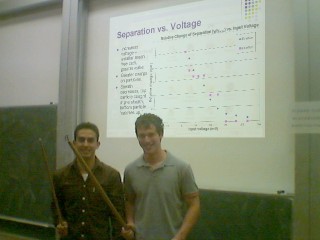

Interview with TSP Students: Tim and Peter
Tim and Peter, two of the TSP students who participated in special project with us this year, gave an excellent talk on Monday 20th of October. The talk was titled "...And you thought simple plasmas were complex!". And today, they just handed in their report on the pairing of particles. The research is still at its initial stage, but hopefully their work will get published in the near future.
Complex Plasma Laboratory once again took the opportunity to interview these two talented students immediately after the completion of their report.
F: Felix
Cheung
T: Timothy Olshansky
P: Peter Berger
F: How do you feel now that you have finished your presentation?
T: I
feel really relieved that the presentation is over. Now the project
report is next on the agenda and i can imagine that it will be as fun if not
more so. (Note: Sarcasm)
P: Relieved... Actually looking foward
to possible future research.
F: Can you explain to our viewers what your project involves?
T: The
project itself was quite simple. It involved measuring the heights
and separations of paired dust particles in the sheath of a RF CCP as we
varied the pressure and input voltage in the system. Essentially, we were
investigating the particle-particle interaction in the system. The fun
part was illuminating the dust and trying to find it on camera. It was a
torture I wouldn't wish on anyone.
P: So in other words, our project
essentially looks at the levitation of dust particles in a plasma.
F: How is your project important in our understanding of complex plasmas and in real life application?
T: Well
if we can understand the way in which two dust particles interact in
a plasma, this could pave the way for understanding more complex phenomena
like voids, acoustic waves etc. The applications are also far reaching, we
could possibly use dusts to grow particles with certain geometries for use
in surface deposition and the like.
P: Well I had to learn the theory surrounding
it, but after completing the
project it all makes much more sense. I have gained an appreciation of
the importance of complex plasmas both theoretically and industrially.
F: So what do you see as some of the challenges while pursuing this project?
T: One
of the challenges was finding the particles, thats for sure! Accurate
modelling was also a hurdle. There are plenty of proposed models for
the phenomena we observed, but they were all modelled in the bulk plasma
and not the sheath region. Trying to simplify the model was a huge challenge!
P: The steep learning
curve and not knowing what the results should be. Not
having a "right" result made the analysis a lot more challenging.
F: Were you satisfied with the supervision and facilities you were given?
T:What
kind of researcher would I be if I said I was happy with the facilites?
Millions of dollars worth of grants would have made me happy!
More seriously though, the supervision was excellent, we had plenty of
feedback and help throughout the whole project so I can't complain about
that, what bothered me most was the pressure gauge - the pain I went
through to control the pressure using a screwdriver is indescribable!
P: Everybody who helped and supervised
was wonderful, all the facilities
needed were in the lab and there was never any problem with asking for
help or advice.
F: Do you see yourself continuing in the research of complex plasma? If not, what do you think are some of the reasons which inhibit your interest in this area?
T: I'd
be more than happy to continue research in plasma physics! Hopefully
i'll be able to get some vacation work, failing that, i'll do everything
to get back in the lab next semester!
P: Yes, I would love to
if the opportunity permits.
F: Well, thanks guys. You guys did a great job this semester. Hopefully, our viewers will get to see you two in the future.
L: Yes
I hope so too. And I hope we will get exposed to the complex plasma
community more in the future.
P: And I hope future first year
students who are considering pursuing in the field of complex plasma
will find our feedback invaluable.
29/10/2004
Personal Profile
Timothy Olshansky is a first year sciences student who participated in the talented student program at the University of Sydney. Prior to this he was studying at the Sydney Boys High School and received the all-round excellence in the Higher School Certificate as a student who appeared on the Distinguished Achievers List for courses totalling a minimum of 10 units in 2003. He enjoys many sports including rowing.
Peter Berger is a first year sciences student who participated in the talented student program at the University of Sydney. Before university, he studied at the prestigious Sydney Grammar School. He also have received the all-round excellence in the Higher School Certificate as a student who appeared on the Distinguished Achievers List for courses totalling a minimum of 10 units in 2003.



FastCounter by bCentral
